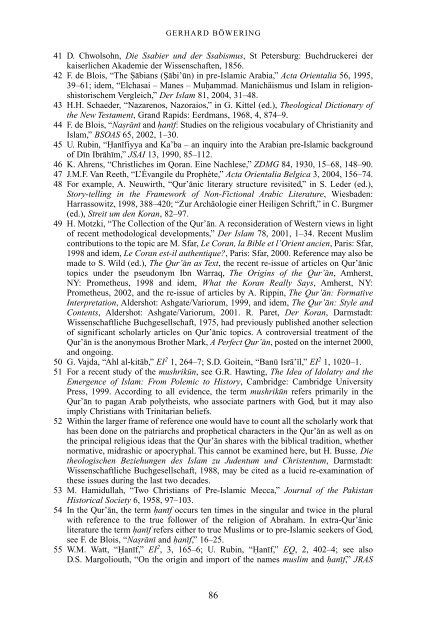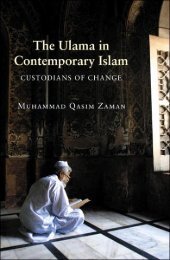The Qur'an in its historical context (pdf - Islam and Christian-Muslim ...
The Qur'an in its historical context (pdf - Islam and Christian-Muslim ...
The Qur'an in its historical context (pdf - Islam and Christian-Muslim ...
Create successful ePaper yourself
Turn your PDF publications into a flip-book with our unique Google optimized e-Paper software.
GERHARD BÖWERING<br />
41 D. Chwolsohn, Die Ssabier und der Ssabismus, St Petersburg: Buchdruckerei der<br />
kaiserlichen Akademie der Wissenschaften, 1856.<br />
42 F. de Blois, “<strong>The</strong> Sabians (Sabi’un) <strong>in</strong> pre-<strong>Islam</strong>ic Arabia,” Acta Orientalia 56, 1995,<br />
39–61; idem, “Elchasai – Manes – Muhammad. Manichäismus und <strong>Islam</strong> <strong>in</strong> religionshistorischem<br />
Vergleich,” Der <strong>Islam</strong> 81, 2004, 31–48.<br />
43 H.H. Schaeder, “Nazarenos, Nazoraios,” <strong>in</strong> G. Kittel (ed.), <strong>The</strong>ological Dictionary of<br />
the New Testament, Gr<strong>and</strong> Rapids: Eerdmans, 1968, 4, 874–9.<br />
44 F. de Blois, “Nasrani <strong>and</strong> hanif: Studies on the religious vocabulary of <strong>Christian</strong>ity <strong>and</strong><br />
<strong>Islam</strong>,” BSOAS 65, 2002, 1–30.<br />
45 U. Rub<strong>in</strong>, “Hanifiyya <strong>and</strong> Ka’ba – an <strong>in</strong>quiry <strong>in</strong>to the Arabian pre-<strong>Islam</strong>ic background<br />
of D<strong>in</strong> Ibrahim,” JSAI 13, 1990, 85–112.<br />
46 K. Ahrens, “Christliches im Qoran. E<strong>in</strong>e Nachlese,” ZDMG 84, 1930, 15–68, 148–90.<br />
47 J.M.F. Van Reeth, “L’Évangile du Prophète,” Acta Orientalia Belgica 3, 2004, 156–74.<br />
48 For example, A. Neuwirth, “Qur’anic literary structure revisited,” <strong>in</strong> S. Leder (ed.),<br />
Story-tell<strong>in</strong>g <strong>in</strong> the Framework of Non-Fictional Arabic Literature, Wiesbaden:<br />
Harrassowitz, 1998, 388–420; “Zur Archäologie e<strong>in</strong>er Heiligen Schrift,” <strong>in</strong> C. Burgmer<br />
(ed.), Streit um den Koran, 82–97.<br />
49 H. Motzki, “<strong>The</strong> Collection of the Qur’an. A reconsideration of Western views <strong>in</strong> light<br />
of recent methodological developments,” Der <strong>Islam</strong> 78, 2001, 1–34. Recent <strong>Muslim</strong><br />
contributions to the topic are M. Sfar, Le Coran, la Bible et l’Orient ancien, Paris: Sfar,<br />
1998 <strong>and</strong> idem, Le Coran est-il authentique?, Paris: Sfar, 2000. Reference may also be<br />
made to S. Wild (ed.), <strong>The</strong> Qur’an as Text, the recent re-issue of articles on Qur’anic<br />
topics under the pseudonym Ibn Warraq, <strong>The</strong> Orig<strong>in</strong>s of the Qur’an, Amherst,<br />
NY: Prometheus, 1998 <strong>and</strong> idem, What the Koran Really Says, Amherst, NY:<br />
Prometheus, 2002, <strong>and</strong> the re-issue of articles by A. Ripp<strong>in</strong>, <strong>The</strong> Qur’an: Formative<br />
Interpretation, Aldershot: Ashgate/Variorum, 1999, <strong>and</strong> idem, <strong>The</strong> Qur’an: Style <strong>and</strong><br />
Contents, Aldershot: Ashgate/Variorum, 2001. R. Paret, Der Koran, Darmstadt:<br />
Wissenschaftliche Buchgesellschaft, 1975, had previously published another selection<br />
of significant scholarly articles on Qur’anic topics. A controversial treatment of the<br />
Qur’an is the anonymous Brother Mark, A Perfect Qur’an, posted on the <strong>in</strong>ternet 2000,<br />
<strong>and</strong> ongo<strong>in</strong>g.<br />
50 G. Vajda, “Ahl al-kitab,” EI 2 1, 264–7; S.D. Goite<strong>in</strong>, “Banu Isra’il,” EI 2 1, 1020–1.<br />
51 For a recent study of the mushrikun, see G.R. Hawt<strong>in</strong>g, <strong>The</strong> Idea of Idolatry <strong>and</strong> the<br />
Emergence of <strong>Islam</strong>: From Polemic to History, Cambridge: Cambridge University<br />
Press, 1999. Accord<strong>in</strong>g to all evidence, the term mushrikun refers primarily <strong>in</strong> the<br />
Qur’an to pagan Arab polytheists, who associate partners with God, but it may also<br />
imply <strong>Christian</strong>s with Tr<strong>in</strong>itarian beliefs.<br />
52 With<strong>in</strong> the larger frame of reference one would have to count all the scholarly work that<br />
has been done on the patriarchs <strong>and</strong> prophetical characters <strong>in</strong> the Qur’an as well as on<br />
the pr<strong>in</strong>cipal religious ideas that the Qur’an shares with the biblical tradition, whether<br />
normative, midrashic or apocryphal. This cannot be exam<strong>in</strong>ed here, but H. Busse, Die<br />
theologischen Beziehungen des <strong>Islam</strong> zu Judentum und Christentum, Darmstadt:<br />
Wissenschaftliche Buchgesellschaft, 1988, may be cited as a lucid re-exam<strong>in</strong>ation of<br />
these issues dur<strong>in</strong>g the last two decades.<br />
53 M. Hamidullah, “Two <strong>Christian</strong>s of Pre-<strong>Islam</strong>ic Mecca,” Journal of the Pakistan<br />
Historical Society 6, 1958, 97–103.<br />
54 In the Qur’an, the term hanif occurs ten times <strong>in</strong> the s<strong>in</strong>gular <strong>and</strong> twice <strong>in</strong> the plural<br />
with reference to the true follower of the religion of Abraham. In extra-Qur’anic<br />
literature the term hanif refers either to true <strong>Muslim</strong>s or to pre-<strong>Islam</strong>ic seekers of God,<br />
see F. de Blois, “Nasrani <strong>and</strong> hanif,” 16–25.<br />
55 W.M. Watt, “Hanif,” EI 2 , 3, 165–6; U. Rub<strong>in</strong>, “Hanif,” EQ, 2, 402–4; see also<br />
D.S. Margoliouth, “On the orig<strong>in</strong> <strong>and</strong> import of the names muslim <strong>and</strong> hanif,” JRAS<br />
86



